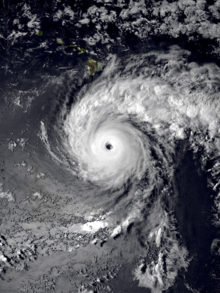 John near peak intensity to the south of Hawaii on August 23 | |
| Meteorological history | |
|---|---|
| Formed | August 11, 1994 |
| Extratropical | September 10, 1994 |
| Dissipated | September 13, 1994 |
| Duration | 4 weeks and 2 days |
| Category 5 major hurricane | |
| 1-minute sustained (SSHWS/NWS) | |
| Highest winds | 175 mph (280 km/h) |
| Lowest pressure | 929 mbar (hPa); 27.43 inHg |
| Overall effects | |
| Fatalities | None |
| Damage | $15 million (1994 USD) |
| Areas affected | Hawaiian Islands, Johnston Atoll, Aleutian Islands, Alaska |
| IBTrACS | |
Part of the 1994 Pacific hurricane and typhoon seasons | |
Hurricane John, also known as Typhoon John, was the farthest-traveling tropical cyclone ever observed worldwide. It was also the longest-lasting tropical cyclone on record globally at the time, until it was surpassed by Cyclone Freddy in 2023.[1] John formed during the 1994 Pacific hurricane season, which had above-average activity due to the El Niño of 1994–1995,[2] and peaked as a Category 5 hurricane on the Saffir–Simpson scale, the highest categorization for hurricanes.
Over the course of its existence, John followed a 13,180 km (8,190 mi) path from the eastern Pacific to the western Pacific and back to the central Pacific, lasting 31 days in total.[3][4][5] Because it existed in both the eastern and western Pacific, John was one of a small number of tropical cyclones to be designated as both a hurricane and a typhoon. Despite lasting for a full month, John barely affected land at all, bringing only minimal effects to the Hawaiian Islands and the United States military base on Johnston Atoll. Its remnants later affected Alaska.
- ^ Cite error: The named reference
wmoprwas invoked but never defined (see the help page). - ^ "Cold and Warm Episodes by Season". August 4, 2014. Retrieved August 11, 2014.
- ^ Lawrence, Miles (1995). "Hurricane John Preliminary Report (page 1)". NOAA. Retrieved May 22, 2006.
- ^ Dorst, Neal (2004). "What is the farthest a tropical cyclone has traveled?". NOAA Tropical cyclone FAQ. NOAA. Archived from the original on May 6, 2009. Retrieved May 22, 2006.
- ^ "Tropical Cyclone: Longest Distance Traveled by Tropical Cyclone". World Meteorological Organization. Retrieved March 9, 2023.